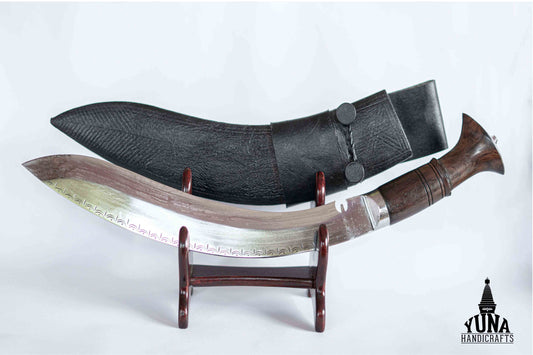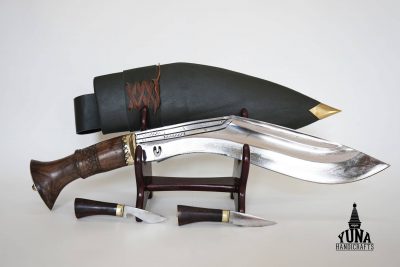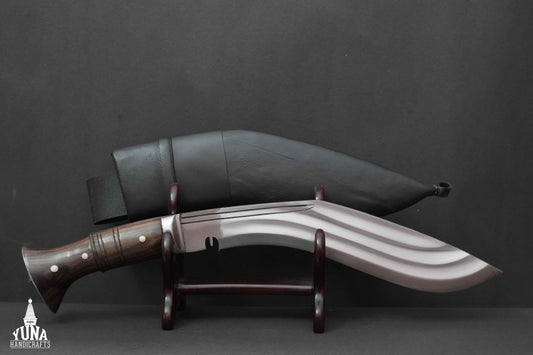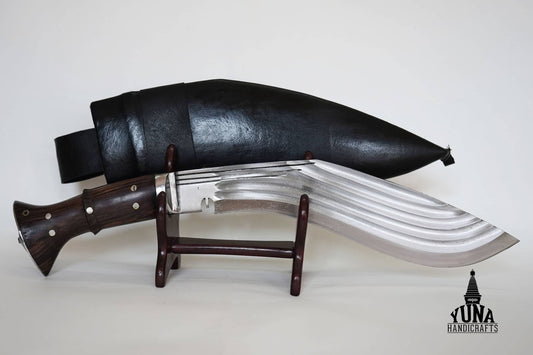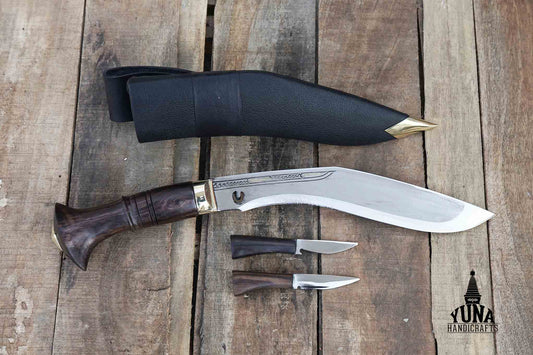
How to Make Kukri: A Complete Guide
Overview of Kukri
The Kukri is the national weapon of Nepal and a weapon used by the Nepali Army. No Gurkha ever steps into the battle without a Kukri. So, it has an excellent value, and the people of Nepal greatly respect the possession of a Kukri.
Kukri is used by the Royal Gurkha Rifles of the British Army, the Garhwal Rifles of the Gorkha regiments of the Indian Army, the Assam Rifles, the Kumaon regiments, and every Gurkha regiment that exists in the world. Kukri is often used in many traditional events in Nepal, as well as Hindu rites like wedding ceremonies, where the Groom holds a Kukri on his waist.
Design of Kukri
Kukri is mainly designed for chopping, and its shape also makes a great effort to create a fine cut with a curved edge. The Kukri design may vary according to the place of origin, the task for which it is made, and the craftsmen who make it.
In general, the Kukri spine may vary from 5-10 mm at the handle with a 2 mm taper by the point. The length of a general-use blade can range from 26-38 cm. A traditional Kukri used for general use can have a 40-45 cm length with a weight of approximately 450 to 900 g.
The Kukri’s weight may also differ due to the construction of the blade. The Kukri’s strength should not be altered, so to keep the power and reduce weight, the blade can be hollowed, or a fuller can be created. The blade usually has a notch at the base, which has various practical and religious meanings.
The Kukri handles are usually made from hardwood or water buffalo horn, but ivory, bone, and metal handles are also becoming popular. The handle often has a flared butt, which allows better control in drawing and chopping.
History of Kukri
The founding of the then Kingdom of Nepal relies on the History of the Kukri. When the kingdom of Nepal was founded in the 16th century, the Kukri was the primary weapon of the Nepali soldiers (Sainik).
The history of the Kukri dates back about 2500 years ago during the time of Alexander the Great and his invasion of the Indian subcontinent. However, there is still a debate on whether Alexander found the weapon on the battlefield and adopted it for the war or brought the Kukri with him when invading the subcontinent.
Either opinion can be valid because the Macedonian version of the sword used by Alexander’s soldiers, known as Kopi, was shorter than the original swords and about the size of a Kukri. However, the real fact is unknown and probably lost to history.
The present design of the famous Kukri was crafted in Nepal’s native hills around the 7th century BC, some 2500 years ago. The Japanese Katana, which is the sword used by Japan’s fabled Samurai warriors, was also curved. History dates these swords to some 900 years back, when the art of crafting the Nepali Kukri was already a thousand years old.
The Kukri is the only ancient battle weapon that is still used on the battlefield at present. It gained popularity for its effectiveness against the British army, which battled in the Anglo-Nepal War. Due to this war, the British-Gurkha relationship was initiated as both sides gained mutual respect, and the relationship still continues to this day. During World War I and World War II, the enemies feared the Gurkha army and the Kukri for their utility and effectiveness.
No Gurkha would ever step on the battlefield without his Kukri, as a Gurkha and his Khukri are ever inseparable. It was issued formally as official military gear under the British leadership in both battle and parade.
Making of Kukri
A Kukri includes three significant parts: the Blade, the Handle, and the Sheath. The assembly of these three completes a Kukri. The Kukri has always been made using high carbon steel, previously called “Himalayan Steel,” extracted from iron ore of the hills, then the “Leak Steel”, which was the railway track steel, and now “Leaf Spring”, the suspension steel in vehicles.
Nepal is a country where thousands of tribes live, among which a tribe called Bishwakarma Kami is famous for making Kukri. The making of Kukri is one of the oldest works of the Kamis and has been the primary source of income for a long time. Similarly, the Saarki tribe is an expert in making the sheath of the Kukri. These two tribes are responsible for completing a single Kukri.
The Kukris are mostly handcrafted and designed. Making a single Kukri requires four men working for the whole day and sometimes more. The raw materials like steel, brass, buffalo horns, and hides are necessary for making the Kukri is selected among the best ones. The makers choose the materials on their own from their villages and local markets.
Initially, high-grade steel, usually taken from a railway track or vehicle suspension, is taken as a small slice. It is repeatedly heated and hammered on an anvil, usually a sled hammer, in the ground alongside the charcoal-fueled forge.
After a shape is generated, the blade is annealed and tempered with water poured into it. The Tempering of the blade gives it extra hardness and strength. For this, the craftsmen pour cold water onto the edge of the heated blade. This process requires great skill, as water should only be spilled on the heated edge and not the whole body. If the entire body gets watered, it may cause cracks in the blade or even break.
The Kukri handle is carved of Rhododendron wood, shaped carefully for getting a good grip even if it gets sticky. The semi-finished blade is inserted in the handle (or Hilt) through its spike-like tang into the handle, rather than a bar-like shank, and revised. The bronze cap that helps provide strength to the handle is hand-made and individually crafted, and is put in each Kukri.
The sharpening of the Kukri is done by using the traditional machine known as “Shan.” The Kukri’s edge is rubbed against the wheel on both sides, making the surface slim and sharp. This process is done until the Kukri gets razor sharp.
The final stage of the making of a Kukri is Buffing and Shining, where the blade and handle of the Kukri are carefully shone and smoothed using the shining machine. The final product is carefully inspected before exporting it and issuing it to the person whose life depends on it.
The Sharpening, tempering of the blade’s edge, and even the sheath’s shaping are all handcrafted, with the machine only being used to lathe for shining the final Kukri. A Kukri is only said to be fair and useful if it slices another Kukri’s spine to some extent of depth.
Different Types of Kukri
Basically, the Kukri is classified into two categories: Eastern and Western Kukri. The Eastern Kukris originate in the towns and villages of the Eastern part of Nepal, and the Western Kukris resemble the towns and villages of Western Nepal.
Sirupate Kukri is one of the most popular Eastern Kukri used in Nepal, where Sirupate means thin-leaf-like, and is more slender, usually with a slightly thinner spine to boot. Other widely popular Kukri of Eastern Nepal are Angkhola Kukri, Chitlange Kukri, Chiruwa Kukri, Dhankute Kukri, Ganjawala Kukri, Panawala Kukri, Bhojpure Kukri, Chainpure Kukri.
Western Kukris are occasionally called Budhuna, a fish with a large head, or Baspate, which means Bamboo-leaf-like. The Western Kukris are broader compared to the Eastern ones. However, the classifications are only made to know about their origins, but both types of Kukri are equally used all over Nepal.
There is another type of Kukri named after the Gorkhali General Amar Singh Thapa and is known as Amar Singh Thapa Kukri. This Kukri depicts the real Kukri used by the General during the war. However, the real Kukri used by him is safely kept at the National Museum of Nepal and is a bit curvier than other Nepali Kukri.
Uses of a Kukri
The Kukri gained popularity during the first Gurkha war and continued to be used even during World War I and World War II. It is widely used as a weapon due to the curved shape, which creates a wedge effect, causing the blade to cut deeper and effectively. Due to the weapon’s weight and design, the user can inflict deep wounds and penetrate large bones. It is used for slaughtering animals for food, cutting meat and vegetables, skinning animals, chopping wood, digging, and various general and household work.

